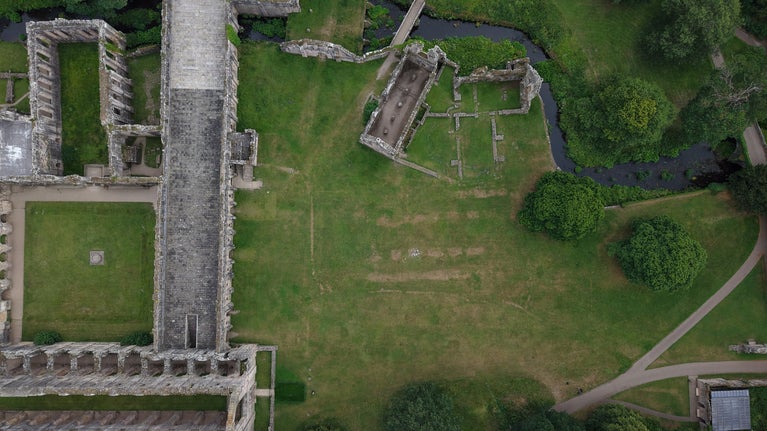Hot and dry weather reveals hidden features under the lawns of historic landscapes
- Published:
- 14 August 2025

Lost buildings under lawns and parkland across the country are being revealed this summer, as a result of the exceptionally dry weather this year.
Parchmarks – which form in very dry weather – are where grass over buried walls or other archaeology dries out at a different rate to nearby areas. In the best cases they leave a clear map of the underground structures.
And thanks to the weather this year, some spectacular examples have shown up across the country, including at Fountains Abbey in North Yorkshire and Mottisfont in Hampshire.
In recent years parchmarks have been seen more often due to the impact of climate change.
Tom Dommett, the National Trust’s Head of Historic Environment said: “Parchmark visibility varies from year to year, historically only showing well every 15 years or so. This year parchmarks are showing more clearly, and have also been recorded earlier in the year, after an exceptionally dry spring.
“While we have seen parchmarks at our places for many years, in more recent years the frequency has noticeably increased, including in 2018 and 2022, as climate change increases the likelihood of hotter, drier weather in spring and summer.”
At the National Trust’s Fountains Abbey in North Yorkshire, the trace of lost buildings can be seen on the West Green. They show foundations where buildings once stood and only show up occasionally.
The marks represent some important lost buildings of the abbey with the largest an aisled hall, believed to be a large Guest Hall. The interior space was divided into aisles by rows of columns, which show up in the parchmarks. The base of one also still survives above ground.
Also now visible, closer to the abbey, is the Lay Brothers’ Cloister, a colonnaded building. The remains of this were removed by William Aislabie in the 1770s to make the west façade of the abbey look more impressive.
National Trust archaeologist Mark Newman said: “The parchmarks are showing really well this year. We have a good clear view of the Guest Hall – a building which shows the importance of the abbey’s ‘hospitality’, one of the monastic duties following Christ’s example. It would have had the capacity, with medieval lifestyles, to have accommodated hundreds of people. It shows that Fountains Abbey has welcomed visitors in large numbers for hundreds of years.”
In addition, the remains of buried 13th- and 16th-century wall foundations at the National Trust’s Mottisfont near Romsey in Hampshire have appeared as parchmarks on the south lawn.
They are the buried remains of monastery buildings including a cloister and various other buildings, as well as later Tudor alterations.
Mottisfont was once a prosperous Augustinian Priory, founded in 1201 by William Briwere or Brewer. It declined after the effects of the Black Death and was dissolved in 1536 by Henry VIII who gave it to a favoured statesman, Sir William Sandys - who died in 1540 - who turned the entire priory buildings into a Tudor house.
It remained until remodelled in the 1700s into its present form, when some of the remains of the former priory as well as Tudor buildings would have been buried under the lawn.
National Trust Archaeologist James Brown said: “These are intriguing glimpses into the oldest history of buildings known here at Mottisfont. We have carried out some geophysical surveys but the buildings have never been dug so their secrets remain hidden except for these rare moments when their outlines appear in the lawns.”